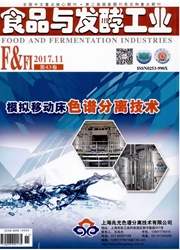

 中文摘要:
中文摘要:
木薯渣是木薯淀粉加工后的废弃物,碳水化合物含量高。实验利用复合酶对木薯渣中淀粉和纤维素等碳水化合物非热水解进行了探索,结果表明:木薯渣具有较好的酶解性能;随着底物浓度的增大,酶解液糖浓度也不断提高,酶解得率逐渐降低;与间歇糖化工艺相比,16%底物在相同的水解条件和相同的酶添加量的条件下,采用4%的起始底物浓度,每隔12h进行补料。葡萄糖得率从53.6%提高到72.4%;以不添加任何营养物质的水解液为原料进行酒精发酵,24h乙醇浓度达到24.9g/L,乙醇得率达到42%,发酵效率为82%,乙醇产率达到1.04g/(L·h),葡萄糖利用率达到97%。
 英文摘要:
英文摘要:
Cassava pulp, which has high carbohydrate content, is the waste of cassava starch processing. Nonthermal hydrolysis of cassava pulp by multi-enzyme and different operation procedures were studied. The results showed that the conversion rate of cassava pulp to glucose with fed-batch hydrolysis increased from 53.6% to 72.4% compared with the batch process. The hydrolysate was able to be used for ethanol fermentation without any nutrition supplementation and ethanol concentration reached 24.9 g/L and glucose utilization rate reached 97% at 24 h, as well as ethanol yield 42% ,fermentation efficiency 82% and ethanol productivity 1.04 g/(L· h).
 同期刊论文项目
同期刊论文项目
 同项目期刊论文
同项目期刊论文
 BIOCONVERSION OF A MIXTURE OF PAPER SLUDGE AND EXTRACTION LIQUOR FROM WATER PREHYDROLYSIS OF EUCALYP
BIOCONVERSION OF A MIXTURE OF PAPER SLUDGE AND EXTRACTION LIQUOR FROM WATER PREHYDROLYSIS OF EUCALYP A Comparison of the Production of Ethanol between Simultaneous Saccharification and Fermentation and
A Comparison of the Production of Ethanol between Simultaneous Saccharification and Fermentation and Bioconversion of paper sludge with low cellulosic content to ethanol by separate hydrolysis and ferm
Bioconversion of paper sludge with low cellulosic content to ethanol by separate hydrolysis and ferm Cis-GPRA synthesis by enzymatic removal of a p-methoxybenzyl protecting group from p-methoxybenzyl-7
Cis-GPRA synthesis by enzymatic removal of a p-methoxybenzyl protecting group from p-methoxybenzyl-7 Fermentative production of ethanol affected by deleting lactate dehydrogenase from Thermoanaerobacte
Fermentative production of ethanol affected by deleting lactate dehydrogenase from Thermoanaerobacte Production of bioethanol from sugarcane bagasse using NH4OH-H2O2 pretreatment and simultaneous sacch
Production of bioethanol from sugarcane bagasse using NH4OH-H2O2 pretreatment and simultaneous sacch Pretreatment of sugarcane bagasse with NH4OH-H2O2 and ionic liquid for efficient hydrolysis and bioe
Pretreatment of sugarcane bagasse with NH4OH-H2O2 and ionic liquid for efficient hydrolysis and bioe 期刊信息
期刊信息
